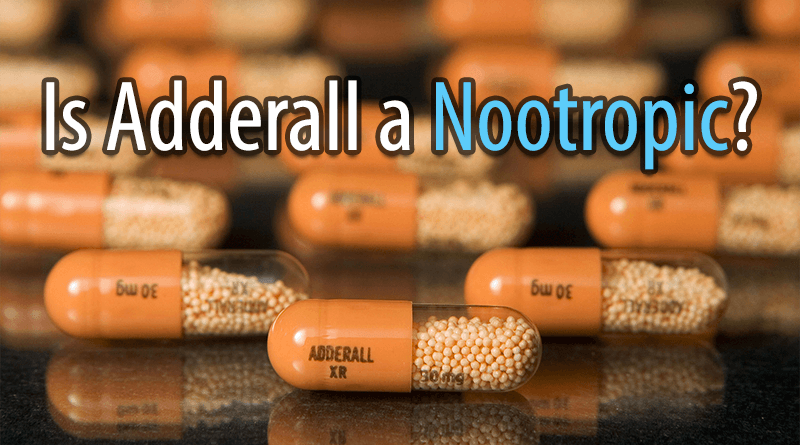Last updated on December 17th, 2020 at 05:43 pm
One of the most misinterpreted concepts about nootropics is that if something enhances brain functioning then it must be a nootropic. Remember, nootropics are cognitive enhancers but not all cognitive enhancers are nootropics. Adderall is a brand name for a mixture of amphetamine salts which contains racemic amphetamine aspartate monohydrate, racemic amphetamine sulfate, dextroamphetamine saccharide, and dextroamphetamine sulfate. Adderall is indeed a cognitive enhancer, but it is far from being a nootropic.
Table of Contents
The benefits of Adderall
Some of the benefits of adderall include:
- Stimulation, arousal, and hyperactivity
- Increased alertness, awareness, and wakefulness
- Increased energy and endurance
- Enhanced attention, focus, and concentration
- Increased desire, drive, and motivation
- Improved cognition, memory, and learning
- Goal-oriented thoughts or organized behavior
- Rapid speech and/or racing thoughts
- Antidepressant benefits or mood lift
- Euphoria and/or rushes of pleasure
- Anxiolysis and/or stress reduction
- Sociability and/or talkativeness, as well as enhanced charisma and/or humor
- Increased self-confidence, arrogance, and/or egotism
- Feelings of power, grandiosity, and superiority
- Analgesia or pain relief
- Hypersexuality and aphrodisiac effects
- Anorexia or decreased appetite and subsequent weight loss
How Adderall works
The benefits of Adderall are indeed appealing, but it is important to know that it is very potent and is far from being like good old caffeine. Unlike caffeine which simply blocks the adenosine receptor, amphetamines force a release of dopamine and norepinephrine from neurons and inhibit monoamine oxidase. Monoamine oxidase (MAO) breaks down dopamine and norepinephrine, along with other neurotransmitters, therefore by inhibiting this enzyme the amount of dopamine and norepinephrine found in the brain increases. Since dopamine is implicated in the brain’s reward system and since amphetamines force a release of dopamine, they are very prone to abuse and in fact, are sold illegally under the common street names ‘speed’ and ‘uppers’ for recreational use.
Dopamine is normally released when you eat food, engage in sexual activity, win at gambling, or just do an activity that you enjoy such as watching tv or playing a game. When taking amphetamines, however, dopamine is released regardless of whether you perform a rewarding activity or not. Even when sitting down and doing nothing, dopamine is still being released. Both dopamine and norepinephrine are released until the amphetamine molecules have been eliminated from the body. Because of this, a comedown is not uncommon after using amphetamines.
Adderall comedown and/or withdrawal effects
Comedown effects of adderall can include such effects as:
- Depression and Dysphoria
- Apathy or not caring about anything
- Anxiety
- Fatigue
- Intense hunger
- Paranoia
- Insomnia
Not only does Adderall have comedown effects, but it also has a significant amount of adverse effects, some of which can be severe.
Side-effects of Adderall
Common side-effects of adderall include:
- Tachycardia (Rapid Heartbeat)
- Anxiety
- Insomnia
- Increased sweating
- Dry mouth
- Abdominal pain
- Decreased appetite (and therefore weight loss)
- Nausea
- Vomiting
- Diarrhea
- Erectile dysfunction
- Restlessness
- Irritability
- Headache
- Dizziness
Severe side-effects of adderall include:
- Severe chest pain
- Severe irritability
- Abnormal electrical activity in the heart (Cardiac dysrhythmia)
- Seizures
- Erratic emotions
- Slowed thinking
- Fainting
- Psychosis (Hallucinations)
- Allergic reaction: rash, difficulty breathing, hives, swelling
Conclusion
While amphetamines certainly offer a great deal of cognitive benefits, they are by no means nootropics as they possess no neuroprotective properties and can be neurotoxic in high doses. While therapeutic doses of amphetamines are not neurotoxic, they still come with a withdrawal effect which can dampen cognitive functioning and is thus considered anti-nootropic.
Alternatives to Adderall
There are many nootropics that can offer similar benefits to adderall without the neurotoxicity associated with amphetamines. In fact, some of them are neuroprotective and can help restore proper dopaminergic function and overall cognitive function.
Perhaps the most popular alternative to adderall is modafinil, a drug also used for the treatment of narcolepsy and daytime sleepiness, modafinil is a strong dopamine reuptake inhibitor but has negligible effects on norepinephrine. Norepinephrine is a neurotransmitter that increases wakefulness, focus, and cognition, however, there is a fine line between just the right amount of norepinephrine and too much or too little. In fact, many of adderall’s side effects can be attributed to this neurotransmitter including decreased appetite, restlessness, anxiety, tachycardia, and more.
Dopamine is thought to be the main neurotransmitter responsible for adderall’s benefits. Adderall works by forcing a release of dopamine while modafinil works by inhibiting reuptake or preventing dopamine from being recycled once it’s been released. This is one of the reasons why modafinil doesn’t make one feel drugged as with adderall.
Modafinil has a long half-life of 12-15 hours meaning it works just as long, if not longer, than adderall and modafinil is not known to cause any type of comedown or crash as is the case with adderall. Furthermore, modafinil is not addictive by any means unlike adderall, which is known to cause dependence and withdrawal effects.
Looking to buy modafinil? Visit the where to buy modafinil page.

